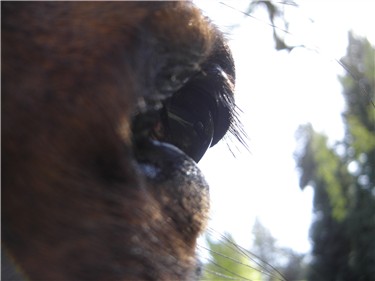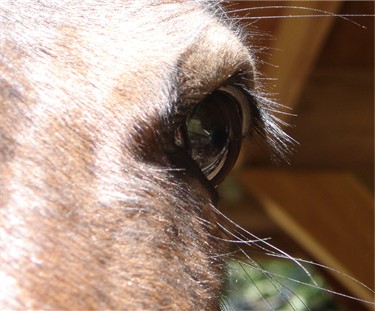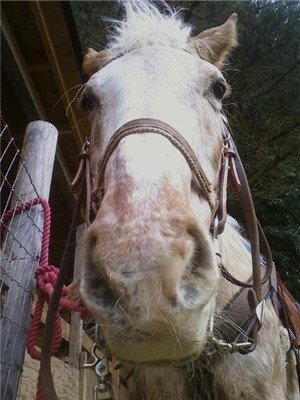Treating Equine Recurrent Uveitis
The Leading Cause of Blindness in Horses
A horse with equine recurrent uveitis can retain their eye site if it is treated aggressively. Learn to recognize the signs and symptoms for successful management of recurrent uveitis.
Recurrent uveitis, also called moon blindness, is caused by one of two things; Leptospriosis bacteria or the Onchocerca cervicalis parasite. Most cases of equine uveitis are caused by the ‘Lepto’ bacteria and it’s the number one cause of blindness in horses, ponies, mules and donkeys. It can also cause abortion and decreased milk supply in lactating mares.

My horse Hana's eye, with eyelids inflamed from recurrent uveitis.

Hana's eye after a steroid treatment - bright and open wide.
The Mystery of Equine Recurrent Uveitis Revealed
For many years doctors were baffled as to the cause of equine uveitis. This is because of the great variety of reactions that horses can have when first exposed to the Leptospriosis bacteria. Some horses will show absolutely zero reaction to the initial lepto exposure. Then 12-18 months later, come down with a raging eye infection, seemingly out of nowhere.
While at other times, some horses show a great reaction within only a few hours or days of being exposed to the bacteria. Before the discovery of microscopes and the Leptospriosis bacteria, the disease was mysterious, without rhyme or reason; so that folks simply blamed it on the moon, hence the term moon blindness.
If recognized early and treated aggressively the outcome can be good. If the uveitis goes undetected and untreated for several days the outcome can be very poor. Because the disease can progress quickly, it is vital to recognize the symptoms and have your horse treated by a veterinarian immediately. No one horse will show all the signs of equine uveitis, rather only a few of symptoms will show themselves. It is also very common for symptoms to show up in only one eye. For reasons unknown, Appaloosa horses are more susceptible to equine uveitis.

Signs of Equine Recurrent Uveitis
- Sensitivity to light, horses will squint or hold eyelid only half open
- Swollen eyelids
- Watery, teary eyes
- Excessive blinking
- Spasms of the eye muscles
- Constricted pupils (small pupils)
- Cloudy eye
- Lethargic
- Fever
- Shivering
- Muscle tenderness
- Loss of appetite
- Increased thirst
- Dehydration
- Yellowing of the whites of the eyes

How Equine Recurrent Uveitis is Spread
The bacteria that causes Moon blindness is shed in the urine of infected animals, thereby contaminating pastures, fields and water sources. The Leptospriosis bacteria can live for up to 20 days in standing water. Leptospriosis outbreaks are common after a flooding, and can be a regular menace in geographical areas that are wet all the time. The bacteria can also be spread through hand contact.
Here on the north coast in Humboldt County, we have a few valleys that are notorious breading grounds for the lepto bacteria. Horses and cattle pastured in these wet valleys are at high risk for contracting equine uveitis. Currently there is no horse vaccine that has been ‘approved’ by the USDA, but there some ‘old timer vets’ in our area, who have routinely vaccinated horses with the cattle vaccine.
My vet told me that the cattle vaccine that had been used on horses, has since been changed, and that horses have a painful reaction at the injection site with the new version. Because the vaccine is not specifically approved for horses, many vets either will not use it, or require the horse owner to sign a release of liability to protect them from lawsuit….how unfortunate in this 'sue happy' society of ours!
Diagnosing Equine Recurrent Uveitis
It is very important that your vet determine if the problem with your horse's eye is caused by the Leptospriosis bacteria, Onchocerca cervicalis parasite or some other eye injury. A blood sample will determine if the Leptospriosis bacteria is the cause. High ‘Lepto’ antibody titers in the blood will confirm this. The horse is treated with antibiotics to reduce the numbers of bacteria. Notice I did not say kill the bacteria, I said reduce the bacteria.
The bacteria will continue to live in the body for many months! Leptospriosis has a 6-12 month half life. Meaning that every 6-12 months the number of bacteria found in the body will be reduced by half, until the bacteria burns itself out. That is, if the animal is not repeatedly exposed to the bacteria, in a contaminated environment. The antibiotics merely give your horse a fighting chance to fend off the disease.

Treating Equine Recurrent Uveitis
The eye is also treated aggressively with an anti-inflammatory steroid ointment that is applied directly to the infected eye several times a day until the eye symptoms go away. As long as the horse has the bacteria in the body, flare-ups can occur randomly in one or both eyes. It is critical that the eye is treated with steroids immediately to prevent the damaging affects of inflammation. The more frequent, long lived and severe the flare-ups are, the higher the odds of vision loss.
Eye inflammation can come on without warning and get ugly fast.
Inflammation can also be taken down just as fast if treated promptly. Awareness by the horse owner is essential. If at all possible, the horse should be moved to a dry environment and kept where the caretakers see the animal daily and act immediately when a flare up occurs. Horses with equine uveitis that are strictly pasture fed and only seen every few weeks are at great risk of loosing their eye site.
A year or so after your horse has contracted the Lepto bacteria, your vet will want to do a repeat blood test, to check for blood level antibody titers. If the titers are significantly reduced in a year’s time, then it can be assumed the bacteria will burn itself out, but that does not mean your horse is out of the woods.
Lepto bacteria causes the eye loose it's natural immunity. The eye will always be more susceptible to eye problems long after the bacteria is gone. You will be instructed to treat the eye for flare-ups as needed, as long as the symptoms of equine recurrent uveitis show themselves.
It is important that the vet determine the specific cause of the equine uveitis, because uveitis caused by Onchocerca cervicalis is treated very differently. Onchocerca cervicalis is a parasite that is treated with Ivermectin after the inflammation of the eye has been brought under control. See Ivermectin and equine recurrent uveitis. Any inflammation of the eye that is due to a scratch or other injury must be ruled out, because the anti inflammatory steroids used to treat equine recurrent uveitis will prevent a wounded eye from healing.
** UPDATE on HANA'S EYE***
Her Lepto titers are down! I will continue to treat her eye as needed.
My beautiful mare Hana, has equine recurrent uveitis. She was diagnosed and treated before I purchased her. Over the course of the last 18 months she has had 4 or 5 flare ups. The first thing I notice is that she will have one bright, wide open eye, and the other eye is held partially open. She will be squinty and sensitive to sunlight. Twice she has displayed swollen eyelids. That’s all the sign that is needed for me to begin treating her eye with the steroid ointment. I am currently waiting results on her repeat blood test. It is expected that her antibody titers will be down and if her symptoms are treated promptly, she will not suffer any significant eye damage.
The more you know about horse diseases, the faster you will be at spotting potential problems. For more information about horse's eyes see the links below. A few minutes spent reading can make all the difference in the world to the horse you love.
More Eye Disease Related Articles:
This information is written for the horseman to better understand and cope with the variety of disease and injury that can occur during the course of horse ownership. Always consult with your Veterinarian regarding the care and treatment of your equine.
Home > Horse Diseases > Equine Recurrent Uveitis


